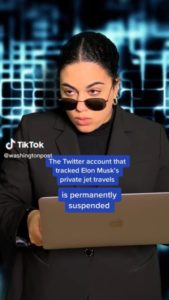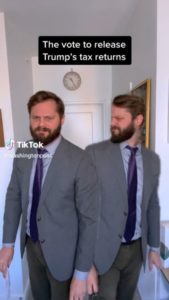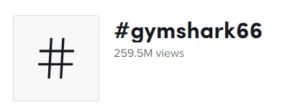Brands that were killing it on TikTok in 2022
In 2022, TikTok continued to thrive as the exciting, entertaining social media platform that the pandemic-world fell in love with. Together, the world learnt the routine to Lizzo’s ‘About Damn Time’, obsessed over Louis Theroux’s ‘Jiggle Jiggle’ rap, and mutually agreed on a shared love of corn. Our global community created and shared content that has reinvented the wheel of day-to-day life for so many of us, and more than ever before, has helped us to once again find the joy in the every day.
But it wasn’t just your ordinary Joe Bloggs who killed it on TikTok in 2022.
Brands (that aren’t your typical Gen Z influencer) have become more and more aware of what it takes to break into the digital world of TikTok. They’ve found new and imaginative ways to push their campaigns and have been quick to jump onto the hottest trends, subsequently scattering themselves across our For You Pages as yet another video we just can’t help but pause to watch, and – let’s be honest – go out to search for and buy.
Some brands have really discovered how to market themselves and appeal to our TikTok-loving nation, so let’s look at some of the brands that have been killing it in 2022. And if you’ve entered 2023 and still don’t think TikTok is for you, I’m sure this blog will give you some food for thought…
Duolingo (@duolingo)
With a current follower count of 5.5 million, Duolingo is showing brands exactly how TikTok is done.
As one of the most popular brands on TikTok in 2022, the language educational company uses their TikTok presence to build awareness through a clear personality, adding their own twist on viral trends and ultimately, having great amounts of fun. Isn’t that what TikTok is all about?
Duolingo discovered that lessening the corporate voice and adding their Duolingo-shaped touch to quirky viral trends is the way to reach the consumer. Creating inside jokes such as Duo – the brand ambassador – being a big fan of Dua Lipa makes the perfect opportunity for followers to connect with the brand and continue coming back for more, leaving them wondering “What will Duo do next?”.
The key takeaway from Duolingo’s TikTok is making content that is enjoyable. Building a humanised brand image with a well-defined, authentic personality, allows the company to move away from the idea that social media is used for promoting and selling a product. Afterall, if the consumer loves the content, the rest speaks for itself.


Washington Post (@washingtonpost)
Since joining TikTok in 2019, The Washington Post has reached an amazing 1.5 million followers, largely thanks to the “Washington Post TikTok Guy” (aka Dave Jorgenson), who adopts an unapologetic ‘dad-joke’ persona to educate Gen Z with current affairs.
As a newspaper, The Washington Post is naturally seen as a brand with a more “serious” tone – something that we generally wouldn’t associate with the likes of TikTok. However, they did the exact opposite of running away, and embraced the opportunity to display a more light-hearted version of themselves.
The success therefore came from a humanised, colloquial tone of voice that speaks directly to the target audience. A recurring theme in this blog, it would seem. Jorgenson is quick to pick up on key digital narratives by using memes, jumping on trends, and building a strong community through audience participations to make The Post’s TikTok account a credible news source to a younger, newer target audience.
With a clear marketing strategy under the belt and a clear tone of voice that is personified through each of the brand’s videos, The Post has made ground-breaking progression on social media. Who would have thought that a 146-year-old newspaper would be out here in 2023 smashing the world of TikTok?!



Gymshark (@gymshark)
TikTok has become a go-to destination for fitness enthusiasts, and fitness apparel brand Gymshark has used that to their every advantage. With a follower count of 4.3 million, we ask ourselves, “What has Gymshark done so right?”
Aside from the fact that Gymshark built its reputation through collaborating with influencers on Instagram – and that very much remains an integral part to their brand – their TikTok presence is all about the trendsetting and maximising the potential that TikTok offers at the press of a button.
We have clearly established now that in order to succeed on TikTok, a brand needs to walk the fine line between promotion and entertainment and be prepared to forgo their corporate voice in exchange for some mockery and light-heartedness. Not only have Gymshark achieved this and jumped on viral trends, memes and hashtags at every given opportunity, they’ve continued to maintain their brand awareness by using TikTok to host campaigns of their own. The #gymshark66 campaign is an initiative developed to help consumers build and maintain new habits going into the new year; a 66-day challenge which asks participants to complete a small daily goal that will in turn, help them to achieve a bigger dream. It is designed to help build self-esteem, confidence, and fitness levels, and boost an online community of exercise lovers. Now going into its 4th year of running, this one campaign alone has so far gained Gymshark millions of followers, likes, comments and views.
Clear brand strategy, I hear you yell? Case. Rested.

Final Thoughts
So, what’s the resounding message here? What can we take away from all these brands killing it on TikTok?
It’s pretty clear that appealing to the consumer is key; speaking in the relevant tone of voice, tapping into trends, and being unapologetically authentic is what is getting these brands heard. There really isn’t a doubt about it. Having that self-awareness, with a clear but flexible marketing strategy is what means brands like Ryanair, Duolingo and The Washington Post are succeeding on one of the worlds most popular social media apps.
Clearly, TikTok rewards genuine people.